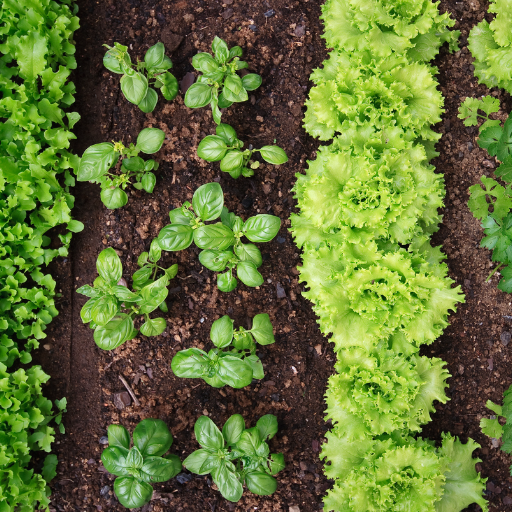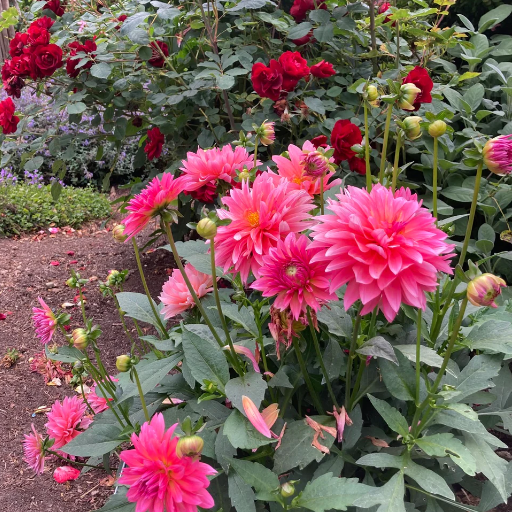Companion planting is one of the essential facets of a profitable gardening process, but it is not only about which plants thrive together. Several plants adversely affect the growth of others, compete for the same nutrients, or even attract pests that feed on neighboring plants. This guide talks about incompatible plants and, in effect, intends to give excellent insight into combinations that ought to be avoided. By understanding this, you will be able to plant a thriving garden in harmony and avoid the common errors that could actually hinder the growth and production of your plants.
Understanding Companion Planting

Companion planting is a method of gardening that considers the adjacent planting of species to promote growth, maintain health, and increase yield. When one understands what plants help each other, a gardener can maximize nutrient uptake, keep pests at bay, or ensure pollination. Conversely, an awareness of plants that do not grow well together is equally helpful; for instance, tomatoes and potatoes should not be planted side by side, as both are susceptible to the same diseases and can infect one another. Likewise, onions tend to stunt the growth of beans and peas. Knowing these relationships will make it easier for a gardener not to commit these commonly encountered blunders and create a well-balanced ecosystem for a thriving garden.
What is Companion Planting?
Planting companion plants is an intentional process of putting two or more plants in the garden to improve their growth, health, or yield. In my experience, it is the natural way of enhancing the ecosystem within a garden by utilizing the special qualities that each plant exhibits. While some offer shade, certain plants act to repel unwanted insects, and still others add essential nutrients to the soil. Knowing which plants are great symbionts and which pairs are to be avoided has demonstrated to me how this living technique builds into a thriving, harmonious garden with less need for chemicals.
Benefits of Companion Planting
Through my personal experience and a large amount of research backing me, partner planting has astonishing benefits. Firstly, insect pests are deterred, and beneficial insects are attracted to plants with complementary properties—for example, marigolds and tomatoes keep nematodes away. Secondly, it increases soil health, for instance, as beans can fix nitrogen into the soil and thereby aid the neighboring crops. Thirdly, it is all about space maximization and yield enhancement, particularly when it involves plants with different growth habits, such as sunflowers that grow tall and cucumbers that grow small. And fourthly, it is the means of lessening the usage of synthetic chemicals to sustain an organic garden. By selecting plant combinations strategically, I have been able to establish a garden that is willing and able to produce.
Common Misconceptions
One such folklore holds that the companion planting technique acts as a threshold for all gardening problems. Formation of half-drugs might see faster growth and fewer pest troubles. Contrasted with such conditions as climate, soil health, water levels in soil, and the plants themselves, this might still create acute effects. Another erroneous conception is that certain pairings so commonly recommended for companion planting, such as tomatoes and carrots, will always yield the best results. Inexact and downright irrecoverable, their success would turn defined according to the specific conditions in your garden. And yet, there are those who believe that this companion planting technique even dismisses the need for good planning and maintenance of the garden. Nevertheless, to make a really successful garden, proper maintenance, including crop rotation and soil nourishment, must be observed. From my research and observation, I have learned that companion planting is a most useful tool, but its best application is within a larger, well-rounded approach to gardening.
Incompatible Garden Plants

Certain plants never grow together side-by-side because their nutrient needs differ, or their growth habits do not coincide, or because chemical interactions occur between them. Onions will compete for nutrients with the beans or peas. Fennel, due to its allelopathic nature, inhibits the growth of most garden plants by chemically affecting the soil in which other plant roots reside. Tomatoes and corn should not be cultivated together, for they attract the same pests, the tomato hornworm being one capable of destroying either crop. Avoid potato-carrot-sunflower combinations since these simultaneously inhibit growth and attract pests. Knowing and implementing these limitations could set the stage for a more productive and healthy garden.
Tomatoes and Potatoes
Planting too close in the garden seems to be my concern for tomatoes and potatoes. This is because both are equally vulnerable to some diseases like blight, which is contagious and can destroy an entire crop. In addition, their growing requirements may be at each other, resulting in lower yields. Separating these potential problems gives me the chance to remove them and provide both plants with the best chance to thrive.
Fennel and Eggplant
Fennel and eggplant are two plants that I also make sure I keep separate. Fennel can emit compounds in the soil that may hamper the growth of nearby plants, eggplant included. The fennel thus receives its own patch, free to grow without ever stressing any other vegetables. This way, I manage to maintain a smooth-running garden free of possible complications.
Peppers and Cabbage
I always make sure to keep peppers and cabbage apart in my garden. While peppers like warm, well-drained soil and a lot of sunlight, cabbage grows well in cooler conditions with a little more moisture. There is competition between the two if grown together, creating an environment that is unusually unsuitable for both. Giving each plant its own space according to its personal requirements ensures a healthier and more productive garden.
Vegetables You Should Plants Never Grow Together

Carrots and dill are two vegetables that should never grow together. Even though both plants are members of the same family, they do not ideally grow well together. Dill saps chemicals from the soil that impair carrot growth, giving rise to stunted roots. Moreover, since similar pests target these two plants, the opposition may encourage greater attacks if grown too close. The best way to prevent this problem would be to plant carrots and dill in different areas of the garden so that they do not compete or adversely affect each other.
Corn and Tomatoes
Gardening might appear to be fine for corn and tomatoes, but they compete and increase each other’s vulnerabilities. In growing all heavy feeders, they demand sufficient nutrients from the soil. When planted together, they can rapidly diminish the nutrients in the soil, thereby stunting growth and reducing yield from both plants. Also, these plants face the same pests and diseases, with corn earworms and tomato fruitworms being two such pests that cause infestations. For the best health of plants and abundant harvest, it would be wise to plant corn and tomatoes in definite sections of the garden, in which both can grow without competing with each other for resources.
Beans and Onions
Beans and onions really should not be grown side by side. The sulfur compounds released by onions into the soil give off a foul smell that lingers therein, or has been said to inhibit the development of beans, interfering with root development and nitrogen fixation. I always ensure these two crops are planted in separate locations where they won’t compete or interfere with each other so that both have the best chance to thrive. By doing this, I am safeguarding my garden and contributing to better yields for both.
Carrots and Parsnips
Carrots and parsnips are quite rewarding to grow but have similar cultural requirements, which need fitted planning. I always make sure the soil is loose, well-drained, and free from stones or hard clods; this will aid in the long and straight growth of these crops. I sow seeds at appropriate distances and thin the seedlings well to avoid direct competition and lateral stunting of their growth. Being root crops, I tend to under-apply nitrogen fertilizer because it encourages the growth of large tops at the expense of root development. Carrots and parsnips prefer cool temperatures, so I plant them early in the season or later on in late summer for a fall harvest. By following these guidelines, healthy and flavorful crops are produced time after time.
Herbs and Their Incompatibilities

A certain few herbs have known incompatibilities, which may arise from their planting methods: some interference might occur to the respective growth in terms of nutrient needs or chemical secretion. For example, fennel and dill should be kept away from most plants, as they can inhibit their growth. Likewise, mint grows aggressively and can dominate nearby herbs; hence, it is better to grow it in containers. Basil is quite adaptable but is best kept away from sage since their contrasting water preferences create unfavorable conditions for at least one. To guarantee the blossoming of their herb garden, learning these incompatibilities helps herbs to find their own best environment.
Chives and Brassica Family
Chives are generally extremely good companion plants for any member of the Brassica family crops that include broccoli, cabbage, cauliflower, and kale. These may grow well side-by-side, and some say that chives may repel aphids and cabbage worms from Brassicas. Nonetheless, care must be taken in spacing so that air circulation, as well as access to nutrients, is ensured for all the plants. By controlling their placement, one can promote a healthier and more resilient setting for their garden.
Monarda and Cucumbers
Monarda, or bee balm as it is commonly called, is a perfect companion plant for cucumbers because it attracts pollinators, mainly bees and butterflies, who play an essential role in cucumber pollination. Also, since their leaves are aromatic, they could help deter certain pests, especially cucumber beetles added advantage. But in good practice, I would suggest that while planting Monarda and cucumbers together, ensure a very good spacing for both Monarda and the cucumber, because too tight spacing can reduce airflow and hence facilitate conditions for fungal diseases. Together, the two plants help foster a more bountiful and lively growing environment.
Fennel’s Impact on Other Herbs
Fennel, the Queen of herbs, makes a great statement. I have learned to plan against this. Due to allelopathy, fennel causes chemical releases into the soil that can inhibit the growth of other plants, especially some herbs – basil, cilantro, or parsley. For this reason, I prefer not to plant fennel alongside other herbs so they do well. Instead, I allow fennel its space in the garden where it has no interference with other plants. Hence, this promotes a nurturing environment for all herbs to prosper.
Specific Plant Pairings to Avoid

Being an allelopathic plant, it inhibits the growth of plants growing beside fennel. Carrot and tomato are the most sensitive vegetables to the chemical release from the root of the fennel plant. One should also keep seeds away from being sown close to fennel, as it might affect their growth. Better healthy growth of all plants can be ensured if the lady gives fennel a separate growing place away from other crops. This way, it cannot interfere with the productivity of the lady’s garden.
Pumpkins and Summer Squash
The more space there is for pumpkins and summer squash, and they get their required full sunlight, the more they will have a thriving atmosphere. This particular plant prefers being planted in soils that have organic matter and good drainage so that they have the nutrient supply for its requirements. Do not plant them too close to each other or beside other sprawling plants, for their tendrils will seriously compete over resources. Corn and beans can be good companion plants for pumpkins and squash as they will grow well under a complementary environment. But avoid planting near potatoes, because that would lead to the competition for similar nutrients and hence hamper the growth of both. Watering and controlling pests regularly throughout the growing season is the key to producing healthy plants and a good harvest.
Peas and Garlic
Generally, peas and garlic are not grown together because the compounds released by garlic and other Alliums into the soil tend to stunt the growth of peas. Incompatibility exists because both plants have differing nutrient and soil requirements tends to create an unbalanced environment for the other. To ensure maximum yields for both crops, plant them apart in different garden plots so they can grow under conditions specifically suited to their needs.
Potatoes and Zucchini
Potatoes and zucchini are quite tricky to grow together since the growing pairs of crops demand almost the same nutrients from the soil, and with competition, they go weak to each other’s detriment. As far as pest attacks and diseases, including squash bugs and powdery mildew, are concerned, they are similar. They spread like wildfire if two crops are kept close. For the best growth, I advise you to plant these vegetables in different sections of your garden and rotate their positions every season. Rotation makes healthy soil, and the shared risk can be reduced with this method. As a matter of fact, this will aid the two crops to grow well and fill your garden with produce.
References
-
Gardenia.net: This guide lists examples of plants that should not be grown together, such as potatoes with asparagus, cucumbers, and tomatoes. Visit Gardenia.net1.
-
Martha Stewart: This article highlights 16 vegetables that should never be planted together, including beans and onions, tomatoes and potatoes, and more. Visit Martha Stewart2.
-
Moms Need to Know: A detailed companion planting guide that explains which plants to avoid pairing, such as beans with garlic or onions. Visit Moms Need to Know
Frequently Asked Questions (FAQ)
Why should tomatoes and peppers never be planted together?
Tomatoes and peppers are both members of the nightshade family, which means they are susceptible to the same diseases. When planted together, they can compete for nutrients in the soil, leading to stunted growth. Additionally, both plants thrive in similar conditions, which may result in one plant overshadowing the other. For optimal growth, it’s best to plant them in separate areas of your vegetable garden. This strategy allows each plant to access the nutrients it needs without the risk of disease transmission.
What happens when cucumbers and monarda are grown together?
Cucumbers and monarda, commonly known as bee balm, should not be planted together due to allelopathy. Monarda emits chemicals that can stunt the growth of cucumbers, making it challenging for them to thrive. This interaction can lead to a decreased yield in your garden. To keep your plants happy and healthy, consider planting cucumbers with companion plants that do not inhibit their growth. By avoiding incompatible plants like these, you can ensure a more productive vegetable garden.
Are there any vegetables that can be grown with cabbage?
Cabbage can be successfully grown with certain companion plants, but it should never be planted near peppers. Peppers and cabbage compete for nutrients and can inhibit each other’s growth. However, cabbage does well when planted with plants like beans, which can fix nitrogen in the soil, benefiting the cabbage. It is important to choose compatible plants to prevent competition and ensure a healthy harvest. Always research the types of plants to find those that complement each other in your garden.
What are the implications of planting corn and tomatoes together?
Corn and tomatoes are not ideal companions for several reasons. Corn can shade the tomato plants, limiting their access to sunlight, which is crucial for their growth. Additionally, both plants have different water needs; corn requires a lot more water compared to tomatoes. This discrepancy can lead to uneven moisture levels in the soil, ultimately stunting the growth of your tomato plants. To create a thriving garden, it’s best to plant them in separate areas, ensuring that each has optimal conditions for growth.
Can beans and onions be planted together in a garden?
Beans and onions are an example of incompatible garden plants that should not be planted together. Onions can stunt the growth of beans due to their strong allelopathic chemicals. This competition for nutrients can lead to reduced yields for both plants. Instead, consider planting beans with plants that enhance their growth, such as corn or squash. By carefully selecting your companion plants, you can create a more harmonious and productive garden.









